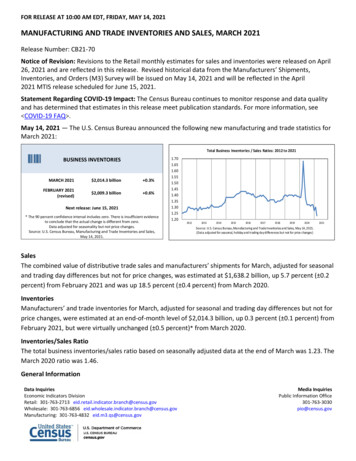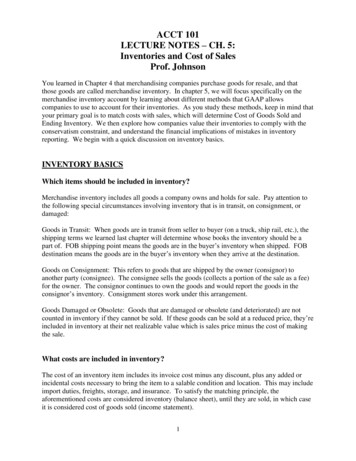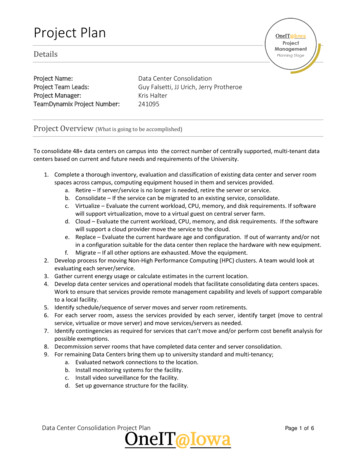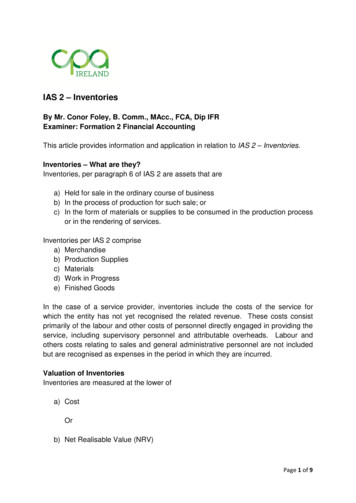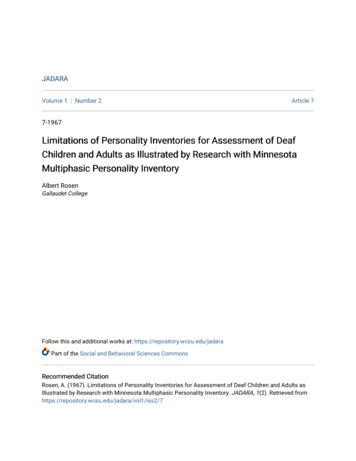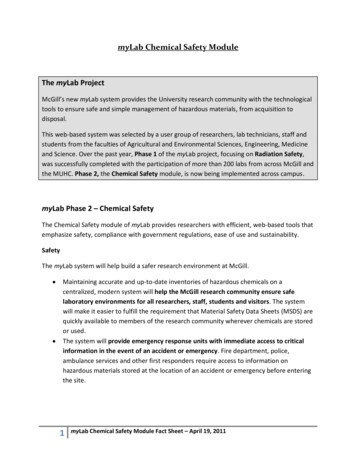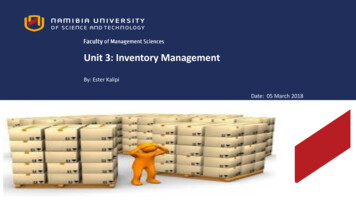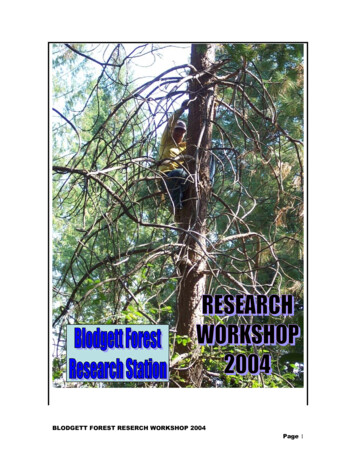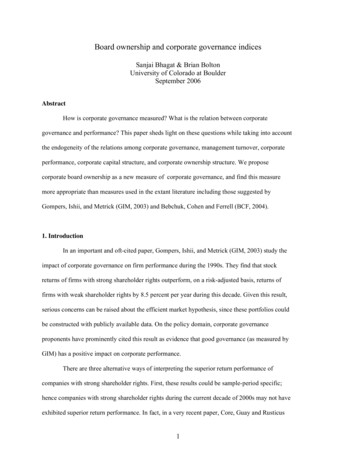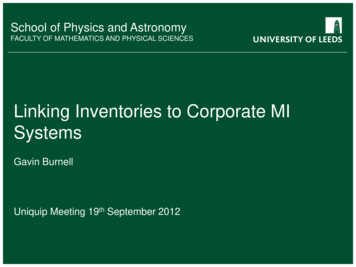
Transcription
School of Physics and AstronomyFACULTY OF MATHEMATICS AND PHYSICAL SCIENCESLinking Inventories to Corporate MISystemsGavin BurnellUniquip Meeting 19th September 2012
OverviewIntroduction: Leeds Equipment Sharing and Management SystemDeveloping a strategic overview of the inventory Improving internal networking Opportunities to realise savings Getting a handle on sustainability of research equipment baseBeyond Inventories: Booking, charging, user managementConclusions
IntroductionLeeds moved over to SAP as its single primary informationstore and platform in early 2000sAsset register and equipment inventory already held in SAPGeneral principle, duplicating data sources without ensuringconsistency not a good ideaTherefore, build the outside world facing inventory on top ofSAP
MIS Wins and LossesWinsLosses Access to ‘primary’ data forall business processes Complexity ! Relationships between datamaintained Personnel records and estatesinformation both link toorganisational structure. Purchase records link peopleand assets to organisationalstructure Asset register links purcasherecords, assets and estateslocations Limited access due to trainingrequirements SAP operators not necessarilyfamiliar with data they areworking with Those familiar with data find itdifficult to check for accuracy Overview of SAP andoperational overview of theUniversity held in different typeof role
Implementation of ESMS“Quick ‘n’ Dirty” solution was to use an existing off-the-shelfreporting tool – “Qlikview” – works fine, but not gearedtowards primary audience – research staff – ad licensingissuesBespoke web application communicating with SAP via webservicesInitial design brief – make it look and feel a bit like web ofscience structured searches, quite old fashioned, butfamiliar to research staffMake something that the owners of equipment could updateand ‘fix’ up their own recordsEnrich the inventory with additional data, pictures, files .
Design SchematicsAdd additional search fieldSearch ScreenUpdate statusIf authenticatedIndex search/lookupwindow (popup?)Login In (link)Search IndexLogin ScreenDocument viewerExecute SearchPagination OptionsSelect Found itemSearch SummaryResultsSort OptionsDetailed ViewFilter OptionsEnter UpdateModule
Things that are EasierLots of ‘added value’ data is already present in a suitable formfor linking E.g. Academic manager (PI) and technical contact already exist inthe HR tables – just need to link to their HR number and name,contact address, email, phone, organisational stricuture alreadythereConsistency when associated data changes E.g. Rooms come and go (!) and people change name Integration with other processes E.g. now all purchases over 25k generate skeleton records in theinventory
Things that are not so easyThe system is inherently more complex more prone to failure andrequires two teams of developers to work on itPotential performance bottlenecks Latency (total bandwidth should be easy) Do you really want to hit the University’s main database on th whim ofexternal users ? The unexpectedly slow operations Can be mitigated with caching of search data or intermediate resultsSecurity ? Need to design the interaction with the MIS carefully But separation of data and presentation can help – interactions mediatedthrough a well definied and limited interface
And the things you get forfree A separate front end communicating with the back enddatabase via a web standards based programming interfaceDoesn’t have to be the inventory website that is talking to theback end E.g. School and department websites can generate custom viewsof data – particularly with rich content added and managed by theequipment owners Services for business/ knowledge transfer/ marketing can all tapinto the inventory – making use of components for corporatecontent management systemsEasy(ier) to hook up to make shared inventory systems.
New ways to look at the dataHaving imposed a classification system we can start to askinteresting questions Where do we own type of equipment ? Who has most of them, who has the most experience ? Is there spare capacity or do we have a shortage across theUniversity ? Can we share service contracts/parts/service visits/technical expertise?Start off simply by looking a clusters of equipment and gettingAcademic managers and technical contacts talking in thesame room
e.g. Chromatography (n 63)
e.g. X-ray Diffraction (n 11)
e.g. Scanning probe microscopy(n 29)
Outcomes from Cluster Meetings (1) There was clear lack of knowledge about facilities available elsewherewithin the institution; There were issues with technical support, with instruments not beingused to capacity owing to insufficient staffing; There were pieces of equipment not being used owing to lack ofmaintenance/funding for repairs; There were difficulties with finance: internal charging, non-FEC costedresearch (PhD students), sustainable management of SRFs/MRFs.
Outcomes from Cluster Meetings (2) Central University web sites will be established, e.g. mass spectrometry@ Leeds, allowing visibility of the complete inventory, not just oneInstitute’s; Opportunities identified for joint internal/external training courses, andindustrial open days; Central Purchasing looking for ways to ensure more efficient servicecontracts are in place across campus ( 2M currently being spent!); Opportunities for recruitment of dedicated service enginesr for high valueequipment (e.g. scanning electron microscopes).
SustainabilityThe key question is “how long is this bit of equipment going to last”Difficult question to answer ! Is this a typical example of such equipment ? Who uses it, how often and todo what ? What do we mean by ‘last’ ? Produce 4* data, work within specification,produce data useful for a PhD student .?Taken a crude, pragmatic approach – assume one can assign an averagelifetime based on genus (the lowest level of our taxonomy) Inspired MRC draft policy on depreciation lifetimes Definitely not a substitute for proper estimates when looking at single items Potentially useful to identify where there are emerging sustainabilityissues
Lieftime of Equipment
Spending to sustain the baseCombine inventorydata with purchaserecords and can get anew picture of whatwe’ve been investingin
Add in our estimatedlifetimes and get whatwe might have tospend These are very crudeestimates, but wouldsuggest that the UKoverall should perhapsspend 500M tomaintain the position of itsresearch equipment base
Refining the pictureWe need to validate whether our lifespans are realistic or indeed whether one can apply a single lifetime perclassificationWhat is the correct value of inflation to apply ?Certainly notheadline inflation Ideally we need a bigger data set to work with, but also needconsensus as to how to do this sort of analysis
Beyond Inventories: Stages inUsing Shared EquipmentIdentify Suitable EquipmentBe Trained to use EquipmentReserve Time to use EquipmentUse Equipment(Teach others to use Equipment)Calculate Usage of EquipmentPay bills (!)
BackgroundStarted work on system in 2003/04 First used in University of Cambridge Nanoscience Cleanroom User lists, equipment lists, booking sheets, time sheets (Apparently) still in use ! Deployed for the University of Leeds Wolfson Cleanrooms (EEE) (2007) Policy control for bookings, central user authentication Depolyed for Condensed Matter Physics Group (2009) Content Management System features Risk Assessment and Safety Mangagement features.
User List ManagementQuestions one finds oneself asking. Who is that ? Are they allowed to use that equipment ? Do they know what they are doing ? and well enough to train somebody else ? Where dp they live and who is in charge of them ?Generic information about individuals (e.g. contact details)Information specific to items of equipment (e.g. Experiencelevel)
Booking SystemsBasic user focussed questions Is X working and when is it available to use next week ? Who is using X before/after me ?Management Policy Who can make bookings, who can edit/delete bookings ? What is the minimum/typical/maximum time that something can bebooked for ? When can a sysem not to be used ? Can we stop uncooperative practices e.g. Speculative booking, overbooking, short notice cancellations etc ?
Usage Monitoring andAccountingTypical questions to be answered: How many hours/days has user A used equipment X ? (and how muchdo they owe us now ?) What fraction of time was the equipment in use/broken/free for ? What fraction of time was the equipment used byEngineers/Physicists/Postgraduates/Post docs/undergraduate projects
Safety ManagentProducing up to date user listsProviding a central repository for risk assessments,instructionsRecording when users confirmed they had readRas/instructionsIndividual user training records
SummaryAs with other UNIQUIP presentations – there is lots of addedvalue to integrating inventories with other data sourcesWe can start to get more holistic pictures of an institution’sresearch equipment assetsIf we are to share equipment effectively, there are substantialmanagement challenges that technology can help us with(but also lots of other hard problems to solve)
Introduction: Leeds Equipment Sharing and Management System Developing a strategic overview of the inventory Improving internal networking Opportunities to realise savings Getting a handle on sustainability of research equipment base Beyond Inventories: Booking, charging, user management Conclusions
